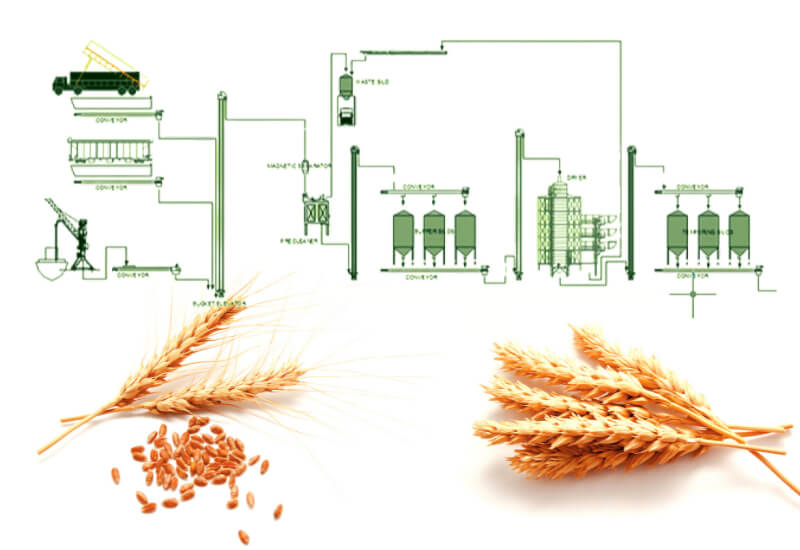The proper performance of all the processes involved in the post-harvest handling of grains and oilseeds, which includes their storage, transport and post-harvest conditioning, is essential to maintain the highest quality. Adequate conservation measures are essential, since deterioration during storage can be very rapid due to the effects of grain respiration.
FACTS
- Current world population is expected to reach 10.5 billion by 2050.
- This increase translates into 33% more human mouths to feed.
- Food availability and accessibility can be increased by increasing production, improving distribution, and reducing the losses.
- Crop production contributes significant proportion of typical incomes in certain regions of the world (70 percent in Sub-Saharan Africa).
- In some Sub-Saharan Africa countries, the post harvesting losses because of the bad storage can reach sometime 37-40 %.
- The PHL “post-harvest grain losses” can be qualitative and quantitative.
INITIAL FACTORS OF HARVESTING
The proper performance of all the processes involved in the post-harvest handling of grains and oilseeds, which includes their storage, transport and post-harvest conditioning, is essential to maintain the highest quality. Adequate conservation measures are essential, since deterioration during storage can be very rapid due to the effects of grain respiration, which can cause the development of fungi and insects that proliferate easily in optimal humidity and temperature conditions.
The three major factors affecting the grain storage are:
- Moisture content
- Temperature
- Storage period
Storage technologies don’t do anything by themselves. Proper management has to be done by the owner.
RECEPTION
Before unloading: Take samples for measuring the temperature and moisture content. Grain laboratory will easily analyze the grain conditions.
During unloading: it is recommendable an aspiration system. In some countries is even mandatory.
- Some aspects regarding this system should be consider:
- Pit intake dimension
- Installed inside a building / cover
- Receiving capacity
- Aspiration volume
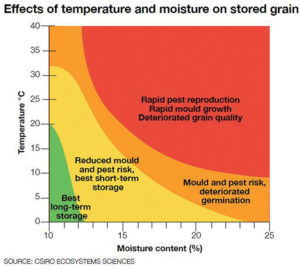
CLEANING PROCESS
Cleaning is the process that removes foreign particles from the bulk.
BUFFER SILOS
After cleaning process, buffer silos should be installed. Why? Because drying process tend to be the bottleneck in every single storage plant.
Ventilation system: should be calculated depending of the grain we are going to store.
Exhaust fans: to prevent condensation.
Over-head cone: This system allow a FIFO flow system , guaranteeing that all grain will remain inside the silo the same period.
DRYING PROCESS
Drying is the process that reduces grain moisture content (MC) to a safe level for storage.
Initial factor: at harvest time the grain contains high MC.
Drying process: Using the ambient air with a low relative humidity or heating air. This will evaporate the moisture from the grain.
Drying rate and temperature:
- Seed, should never exceed 43ºC
- Grain processed: should never exceed 60 – 65ºC
Recommendations:
- Dryer election will depend on your technical requirement.
- Get the knowledge from the dryer manufacturer: training.
- Clean before dry. Impurities in grain bulk reduce the air flow and make it non homogeneous flow creating priority paths.
- Do not mix wet and dry grain.
- Take samples: control the moisture content and temperature in the drying process.
- Experience in previous drying will lead you to increase the drying efficiency.
- Dry a maximum of 5% of the moisture content at a time and then leave the grain to rest for a minimum of 8 – 12 hours.
TEMPERING SILOS
Tempering silos are used to cool down the grain and make the bulk grain uniform in terms of temperature and MC. Depending of the storage capacity, we can cool down the grain either using a tempering silo or in the final storage system. How to do ventilation at this point?
- Ventilation system: centrifugal fans or chillers.
- Exhaust fans: to prevent condensation.
- Over-head cone: This system allow a FIFO flow system, guaranteeing that all grain will remain the same period inside the silo.
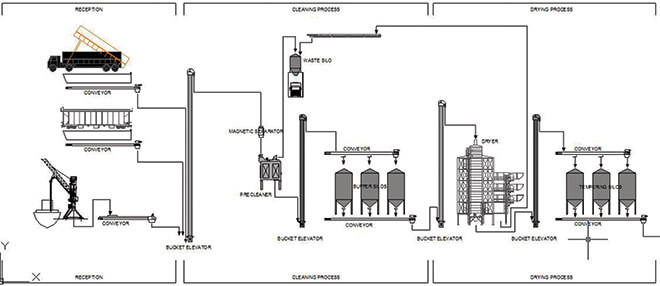
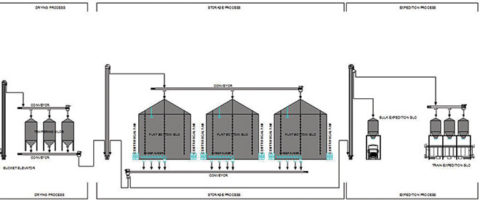
VENTILATION SYSTEM
Because of the tropical climate of some countries, ventilation systems using centrifugal fans are no longer sufficient and cooling systems are necessary. Coolers or centrifugal fans can be used in steel silos, concrete silos and warehouses.
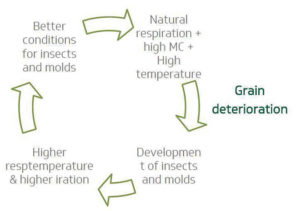
Moisture content required for safe storage for different storage periods.
Considerations:
- Grain column height.
- Priority ventilation paths.
- Ventilation grills.
- Exhaust fans.
TEMPERATURE MONITORING SYSTEM
Simple and accurate device made up of three elements: control center, probes and electronic module of multiplexation.
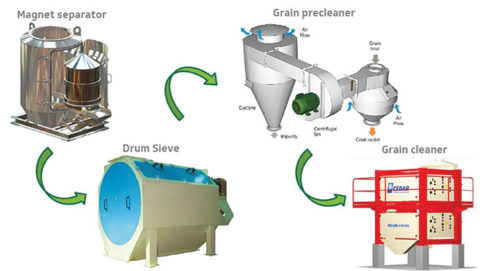
Traditional methods of grain storage:
Warehouse – gunny bags stacked
CAP – Covered and Plinth in open space
Silos – Bulk grain stored in silos: Concrete silos, Galvanized steel, Silo Bag
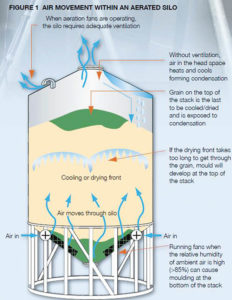
Bibliography
Adams, J. M. 1977. “A review of the literature concerning losses in stored cereals and pulses, published since 1964.” Trop. Sci, 19, 1-28.
Agricultural Research Service (ARS). 2008. National nutrient database for standard reference. United State Department of Agriculture, Washington, DC.
Alexandratos, N., and J. Bruinsma. 2012. “World agriculture towards 2030/2050: the saving water. From Field to Fork-Curbing Losses and Wastage in the Food Chain 2012 revision.” Working paper: FAO: ESA No. 12-03, p.4.
Basavaraja, H., S. B. Mahajanashetti, and N. C. Udagatti. 2007. “Economic analysis of post-harvest losses in food grains in India: a case study of Karnataka.” Agricultural Economics Research Review 20(1).
Agricultrual Eingineering Unit. International Rice Reserarch Institure (IRRI)
International Rice Research Institute The Rice Plant and How it Grows. knowledgebank.irri.org
Bureau of Postharvest Research and Extension,CLSU Cmpd., Science City of Muñoz, Nueva Ecija 3120, 2008
Food and Agriculture Organization of the United Nations. FAO
FAOSTAT. Retrieved December 26, 2013
Instituto Nacional de Tecnología Agropecuaria (INTA).
Gescaser www.gescaser.com
Sodeca www.sodeca.com

